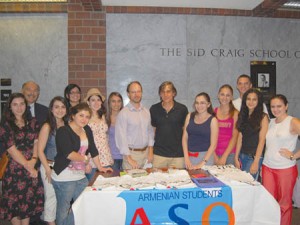Evelyn Demirchian
Staff Writer

September 14 marked the beginning of the Armenian Studies Program Lecture series for Fall 2011. Ara Oshagan presented excerpts from Father Land, a compilation of his photography, as well as commentary from Oshagan and his father—acclaimed writer and literary critic Vahe Oshagan. The book recounts the father and son’s visit to Nagorno-Karabakh.
Prof. Barlow Der Mugrdechian, Director of the Armenian Studies Program, introduced Oshagan to the packed audience of students and community members in the Alice Peters Auditorium of the University Business Center.
It took a decade of commitment until the completion and then publication of Ara and Vahe Oshagan’s photojournalistic expeditions into Nagorno-Karabakh in Father Land. The younger Oshagan spent much of this time accumulating nearly 10,000 photos that he spent over two years editing down.
“We went there together as two artists to work together, in parallel, to bring each others’ expression into one,” Oshagan said.
The photographer and his father first ventured into Nagorno-Karabakh on New Year’s Eve 1999 to begin their documentation of the lives and stories in the new nation. Vahe Oshagan, who passed away in 2000, was a famous poet and author, winning several prestigious awards for his lifetime achievements.
The title Father Land is a play on words. It acts as a symbol for the Oshagan family, the Armenian national heritage, and of the interconnectedness between the land and its people.
While Oshagan presented the photographs, he related several stories to the audience, adding greater interest to the presentation. Taken in black and white, each photo stands alone as a portrait of the individuals he encountered from Stepanakert (capital of Karabagh) to Shushi.
“I’m more attracted to the black and white because I’m more interested in shapes,” Oshagan said. “I’m very interested in composition within the frame and off the frame, so, black and white is more about shape and form and structure. I see better in black and white.”
Separated into several “pseudo-sections,” the book delves into themes of death, the aftermath of war, and of “the absence of a presence”—the void left by those who had died in battle. Virtually every home Oshagan visited had photos of the fallen soldiers or lost loved ones. Featured heavily in Father Land are such evocative images as children playing with leftover bombshells, or running among burnt-out ruins.
Yet, the book also contains as much about life as it does about death. Rebirth is also a recurring theme—images of weddings and playful children dot the narrative in contrast to the more serious realities of residents’ lives.
“The mountains and people are interchangeable realities here,” said Vahe Oshagan in a quote from the book. Much of the presentation asserted the ruggedness of not only the region’s geography, but also the people and culture.
“People are rather more inclined to communicate by means of looks, or various forms of silence, in a nod or ceremonious pantomime, rather than speaking,” said Vahe Oshagan.
Years of instability in addition to the rough climate have hardened those living in Nagorno-Karabakh, and Father Land highlights the consequence of this—the endurance of their spirit.
Working under a de facto government, Nagorno-Karabakh has yet to be recognized as an independent state. Since the war for independence that lasted from 1988-1994, Karabagh and Azerbaijan have had a cease-fire agreement. A tense peace is continuing, but minor offences have upset whatever stability there is.
There is hope that with cultural and humanitarian works such as Father Land a route to peace and recognition will be reached. Father Land is a publication of Powerhouse Books of New York.
 Hye Sharzhoom Armenian Action
Hye Sharzhoom Armenian Action